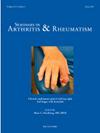Performance of sit-to-stand, timed up-and-go, and six-minute walk tests in home and office settings in patients with idiopathic inflammatory myopathy
IF 4.4
2区 医学
Q1 RHEUMATOLOGY
引用次数: 0
Abstract
Background
Patients with idiopathic inflammatory myopathies (IIM) frequently experience limitations in their physical function. Sit-to-stand (STS), timed-up-and-go (TUG), and six-minute walk distance (6MWD) are task-oriented functional tests that can provide objective information about physical function. In this study, we assess their measurement properties in office and home settings.
Methods
Adults with IIM were enrolled in a prospective study. Patients performed the functional tests (STS, TUG, 6MWD) at 0-, 3- and 6-months, and self-performed these tests at home within 14-days of the visit. Several patient centered outcome measures (PCOMs) were obtained: fatigue (visual analog scale [VAS]), pain (VAS), quality of life (SF-36), physical function (PROMIS, SF36), and physical activity (Actigraphy). Spearman correlation, effect size, standardized response mean, and regression models were used to assess cross-sectional and longitudinal association between functional tests and other measures.
Results
Fifty patients (mean age 51.6, 60% female) were enrolled. Twenty-four, 23, and 20 completed at-home STS, TUG, and 6MWD, respectively. STS and TUG showed strong test-retest reliability at both home and office settings. 6MWD was significantly higher at office setting, whereas TUG/STS was comparable between home and office. All three functional tests significantly discriminated between active vs inactive disease and had significant cross sectional and longitudinal association with PCOMs of physical function, quality of life, and physical activity.
Conclusion
STS, TUG and 6MWD have good test-retest reliability, validity and responsiveness. 6MWD has poor reliability when self-performed at home, while STS/TUG perform similarly in the office and home settings.
特发性炎性肌病患者在家庭和办公室环境中进行坐立、定时起身和6分钟步行测试的表现
背景:特发性炎症性肌病(IIM)患者经常经历身体功能的限制。坐立(STS)、计时起身(TUG)和6分钟步行距离(6MWD)是任务导向的功能测试,可以提供有关身体功能的客观信息。在本研究中,我们评估了他们在办公室和家庭环境中的测量特性。方法成人IIM患者入组一项前瞻性研究。患者在0个月、3个月和6个月时进行功能测试(STS、TUG、6MWD),并在访视后14天内在家中自行进行这些测试。获得了几个以患者为中心的结果测量(PCOMs):疲劳(视觉模拟量表[VAS])、疼痛(VAS)、生活质量(SF-36)、身体功能(PROMIS, SF36)和身体活动(Actigraphy)。使用Spearman相关、效应量、标准化反应均值和回归模型来评估功能测试与其他测量之间的横断面和纵向关联。结果50例患者入组,平均年龄51.6岁,女性占60%。分别完成24台、23台和20台STS、TUG和6MWD作业。STS和TUG在家庭和办公室环境中都显示出很强的重测信度。6MWD在办公室环境下明显更高,而TUG/STS在家庭和办公室之间是相当的。所有三项功能测试都能显著区分活动性疾病和非活动性疾病,并与身体功能、生活质量和身体活动的PCOMs具有显著的横断面和纵向关联。结论sts、TUG和6MWD具有良好的重测信度、效度和响应性。6MWD在家中自行操作时可靠性较差,而STS/TUG在办公室和家庭环境中的表现相似。
本文章由计算机程序翻译,如有差异,请以英文原文为准。
求助全文
约1分钟内获得全文
求助全文
来源期刊
CiteScore
9.20
自引率
4.00%
发文量
176
审稿时长
46 days
期刊介绍:
Seminars in Arthritis and Rheumatism provides access to the highest-quality clinical, therapeutic and translational research about arthritis, rheumatology and musculoskeletal disorders that affect the joints and connective tissue. Each bimonthly issue includes articles giving you the latest diagnostic criteria, consensus statements, systematic reviews and meta-analyses as well as clinical and translational research studies. Read this journal for the latest groundbreaking research and to gain insights from scientists and clinicians on the management and treatment of musculoskeletal and autoimmune rheumatologic diseases. The journal is of interest to rheumatologists, orthopedic surgeons, internal medicine physicians, immunologists and specialists in bone and mineral metabolism.

 求助内容:
求助内容: 应助结果提醒方式:
应助结果提醒方式:


